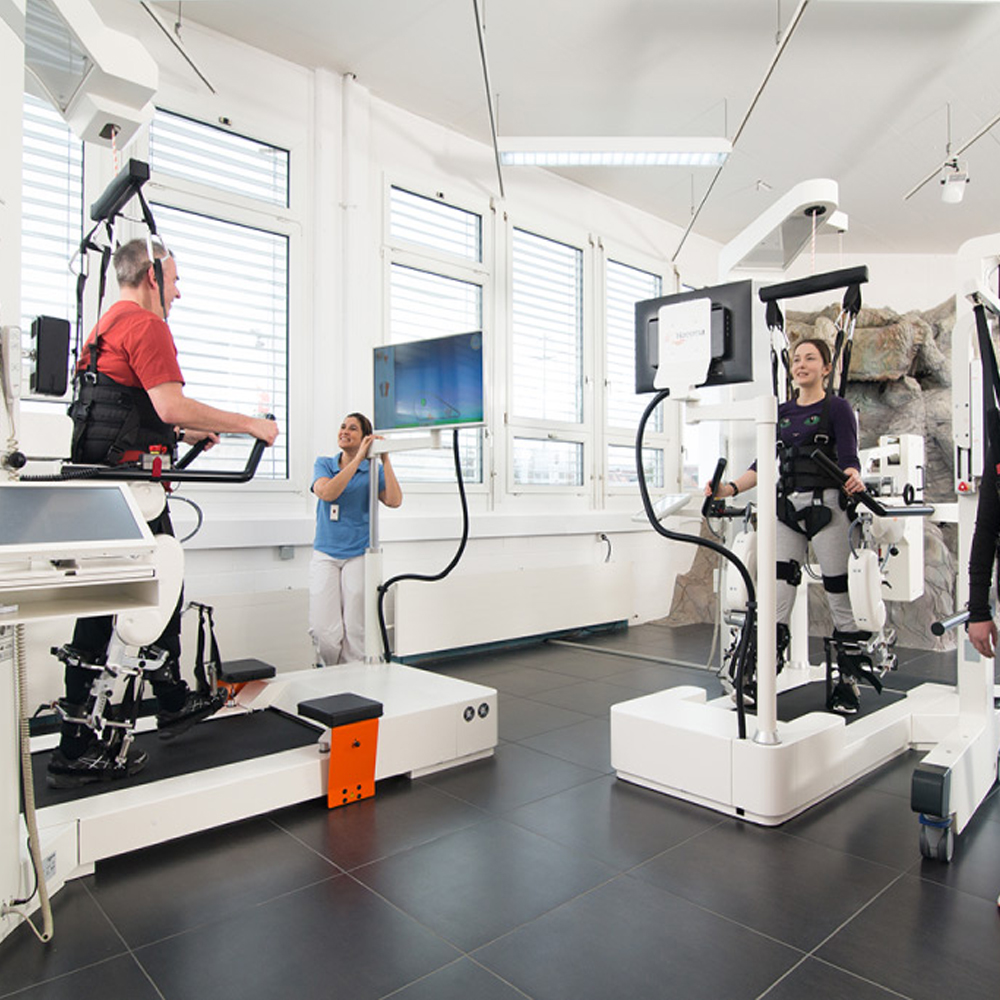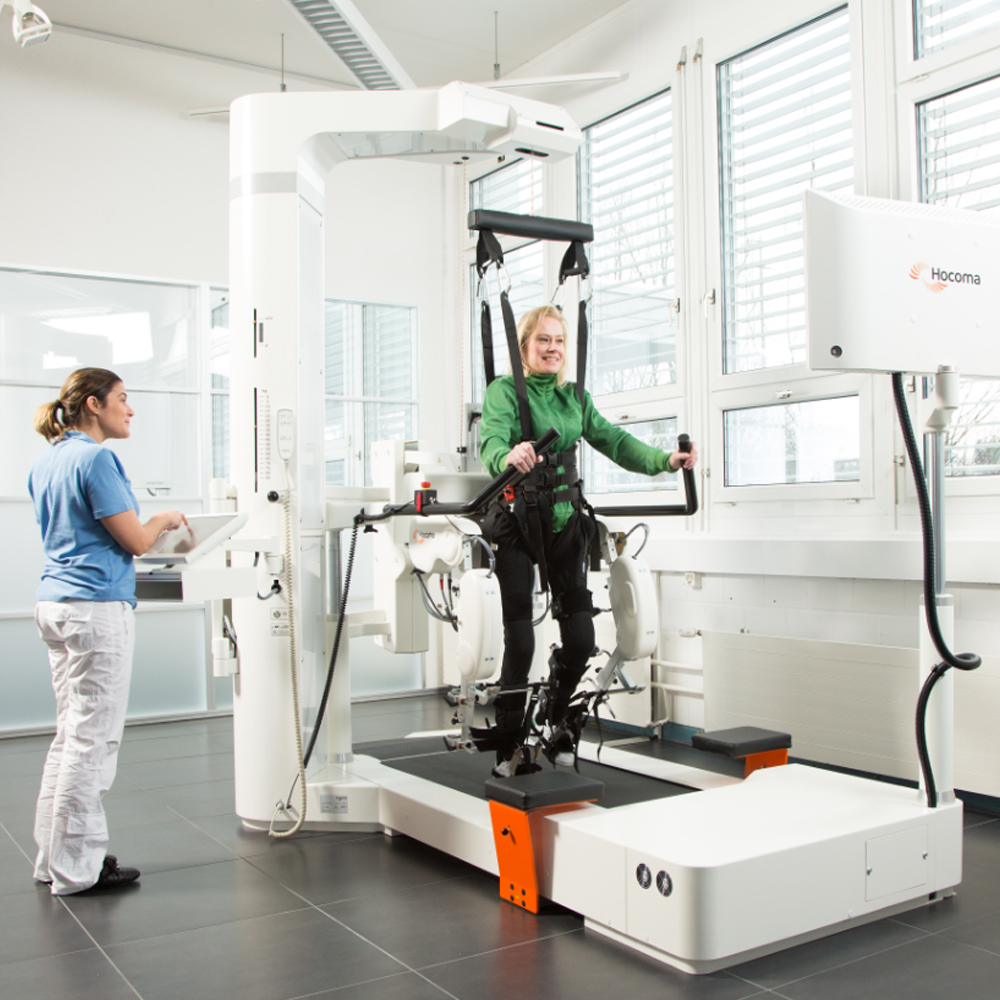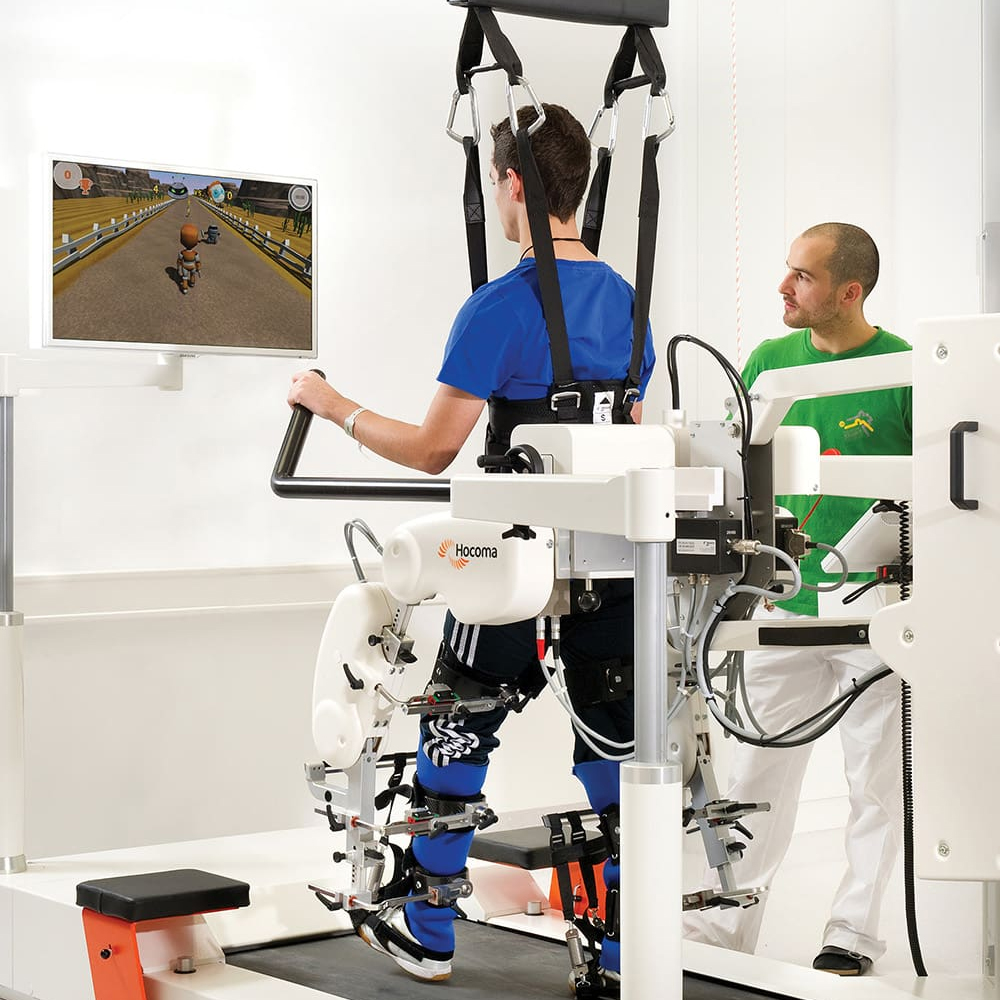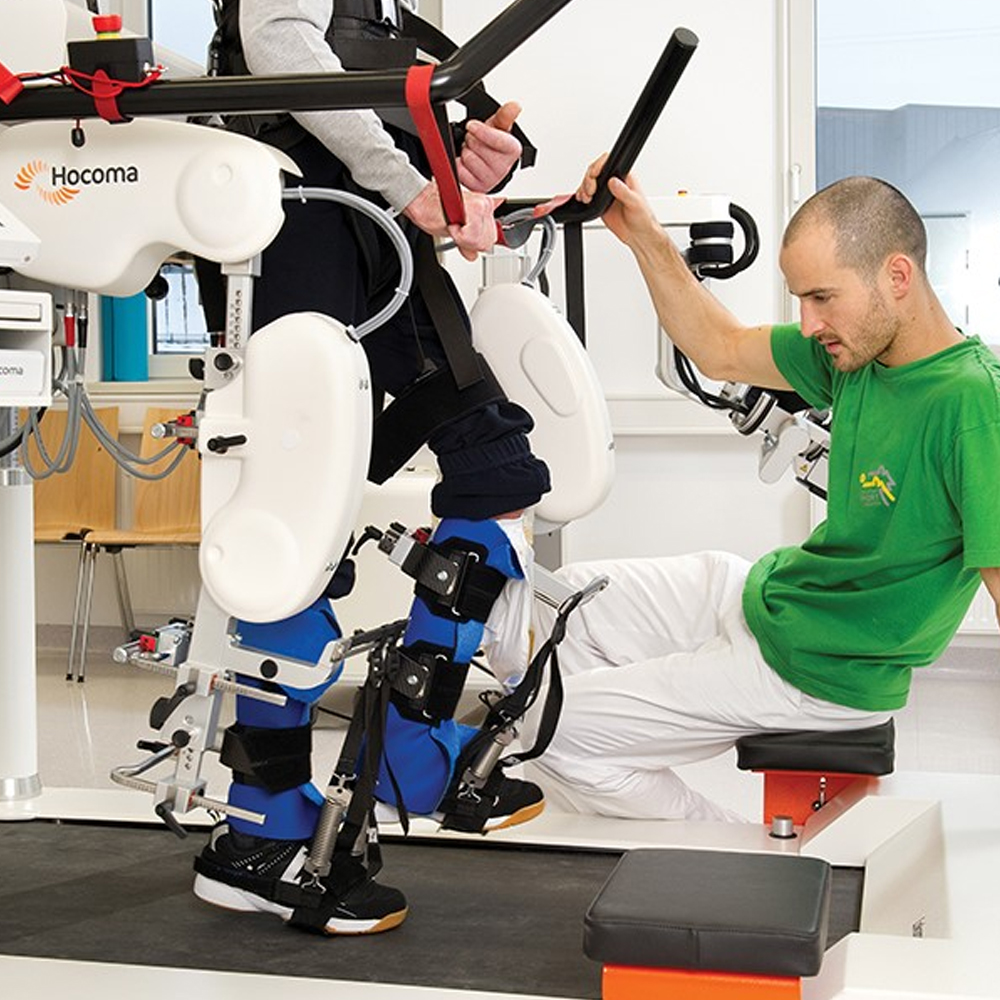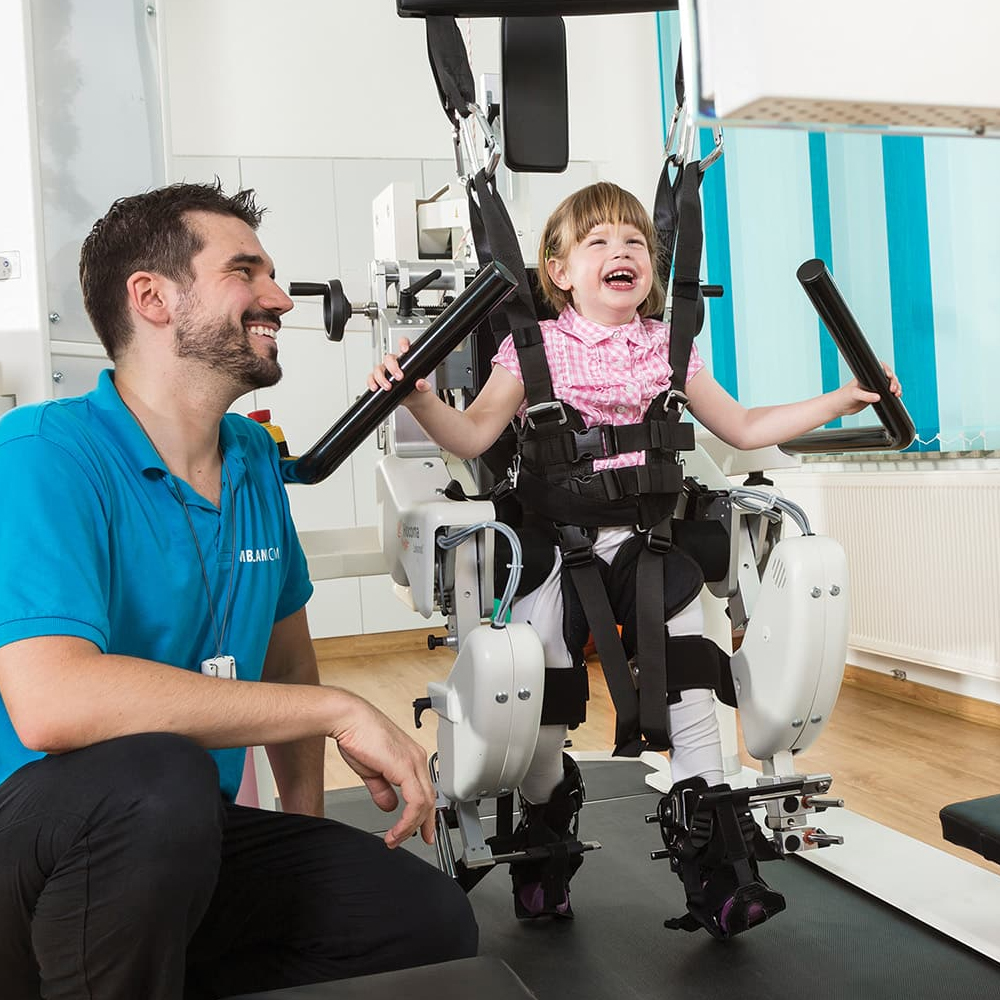Burtom ‣ Technologies ‣ Lokomat (Robot-Assisted Gait Training System)
Language: 🇬🇧 English | 🇹🇷 Türkçe
Lokomat (Robot-Assisted Gait Training System) Overview

 The Lokomat is a revolutionary robotic device designed to assist individuals with impaired mobility in regaining their ability to walk. It combines cutting-edge robotics with advanced computer technology to provide tailored gait training and rehabilitation to patients with various neurological or musculoskeletal conditions.
The Lokomat is a revolutionary robotic device designed to assist individuals with impaired mobility in regaining their ability to walk. It combines cutting-edge robotics with advanced computer technology to provide tailored gait training and rehabilitation to patients with various neurological or musculoskeletal conditions.
This state-of-the-art system comprises a robotic exoskeleton that supports the user’s legs and pelvis, along with a body weight support system and a treadmill. Through precise control and feedback mechanisms, the Lokomat enables individuals to engage in repetitive, task-specific walking exercises while receiving real-time guidance and assistance.
The Lokomat offers adjustable levels of support and resistance, allowing therapists to customize the training intensity according to each patient’s needs and progress. Its intuitive interface and interactive visual feedback enhance the user’s engagement and motivation throughout the rehabilitation process.
With its ability to provide consistent and standardized therapy sessions, the Lokomat facilitates targeted rehabilitation, leading to improvements in walking function, gait symmetry, and overall mobility. Its user-friendly design and adaptable features make it a valuable tool in clinical settings for optimizing the recovery outcomes of individuals with walking impairments.
What is Lokomat (Robot-Assisted Gait Training System) and How Does It Work?

Introduction: Lokomat, a Robot-Assisted Gait Training System, is an advanced rehabilitation device designed to assist individuals with impaired walking ability. This innovative system combines robotic technology with physical therapy to facilitate gait training and improve locomotor function in patients with neurological or orthopedic conditions.
Working Principle: The fundamental principle behind Lokomat is to provide repetitive, task-specific gait training in a controlled and customizable environment. The system consists of a robotic exoskeleton that supports the patient’s lower limbs and guides their movement along a treadmill. Integrated sensors and algorithms monitor the patient’s gait pattern and adjust the level of assistance provided by the robotic system accordingly. This personalized approach enables patients to engage in intensive and repetitive gait training sessions tailored to their specific needs and abilities.
Applications and Importance: Lokomat is utilized in a variety of clinical settings, including rehabilitation centers, hospitals, and outpatient facilities, to address mobility impairments resulting from neurological disorders such as stroke, spinal cord injury, multiple sclerosis, and cerebral palsy, as well as orthopedic conditions like joint injuries and surgeries. The significance of Lokomat lies in its ability to offer targeted rehabilitation interventions that promote motor recovery, enhance walking function, and ultimately improve the quality of life for individuals with mobility limitations.
Clinical Benefits: Clinical studies have demonstrated several benefits associated with Lokomat-assisted gait training, including improved walking speed, endurance, and symmetry, enhanced muscle strength and coordination, and greater patient satisfaction and motivation. The system’s interactive feedback and adjustable parameters allow therapists to monitor progress, modify treatment plans, and optimize rehabilitation outcomes for each patient.
Conclusion: In summary, Lokomat represents a cutting-edge approach to gait rehabilitation, harnessing the power of robotics and technology to facilitate intensive, targeted, and personalized training sessions for individuals with impaired walking ability. By offering a supportive and adaptable platform for gait training, Lokomat plays a crucial role in promoting recovery, restoring mobility, and improving the overall well-being of patients undergoing rehabilitation.
Exploring the Basic Principles and Applications of Lokomat in Supporting Patients' Walking Ability

Introduction: Lokomat, a revolutionary Robot-Assisted Gait Training System, is engineered to aid individuals with compromised walking capabilities through advanced rehabilitation techniques. This article delves into the fundamental principles of Lokomat, its application in supporting patients’ walking ability, and its significance in the field of rehabilitation.
Basic Principles of Lokomat: Lokomat operates on the principle of providing precise and repetitive gait training in a controlled environment. The system comprises a robotic exoskeleton that assists the lower limbs of patients during treadmill-based gait training sessions. By utilizing integrated sensors and algorithms, Lokomat analyzes the patient’s gait pattern and adjusts the level of assistance provided by the robotic exoskeleton accordingly, ensuring personalized and effective rehabilitation.
Supporting Patients’ Walking Ability: Lokomat is employed to support patients’ walking ability by offering targeted and intensive gait training sessions. Through its robotic exoskeleton and treadmill setup, Lokomat provides mechanical support to the lower limbs, enabling patients to engage in repetitive walking movements while receiving real-time feedback and guidance. This personalized approach helps patients with neurological or orthopedic conditions to improve their walking function, regain mobility, and enhance their overall quality of life.
Applications and Importance of Lokomat: Lokomat finds applications in various clinical settings, including rehabilitation centers, hospitals, and outpatient facilities, where it plays a crucial role in addressing mobility impairments resulting from neurological or orthopedic disorders. The importance of Lokomat lies in its ability to deliver tailored rehabilitation interventions that promote motor recovery, improve walking function, and boost patient motivation. By facilitating intensive and personalized gait training sessions, Lokomat contributes significantly to the rehabilitation process, ultimately helping patients achieve better functional outcomes and greater independence in walking.
Conclusion: In conclusion, Lokomat stands as an innovative and effective tool in supporting patients’ walking ability through its advanced robotic technology and personalized rehabilitation approach. By adhering to basic principles of precise gait training and offering tailored interventions, Lokomat plays a pivotal role in enhancing the mobility and quality of life of individuals undergoing rehabilitation for neurological or orthopedic conditions.

Lokomat System and Basic Components:
The Lokomat system comprises several key components, including a robotic exoskeleton, a body weight support system, a treadmill, and a control unit. The robotic exoskeleton is a pivotal component that interfaces with the patient’s lower limbs, providing mechanical support and guiding their walking movements. The body weight support system ensures safety and stability by adjusting the amount of weight-bearing during gait training sessions. The treadmill facilitates controlled walking exercises, while the control unit orchestrates the system’s operation and monitors the patient’s progress.
How Does Lokomat Support the Patient’s Walking Movements?:
Lokomat supports the patient’s walking movements by employing a sophisticated robotic exoskeleton that interfaces with the lower limbs. During gait training sessions, the robotic exoskeleton provides assistance to specific joints, mimicking natural walking patterns and facilitating repetitive movements. Integrated sensors detect the patient’s gait parameters and adjust the level of assistance in real-time, ensuring a personalized and effective rehabilitation experience. By supporting and guiding the patient’s walking movements, Lokomat promotes motor learning, improves muscle strength, and enhances gait patterns.
Clinical Applications of Lokomat:
Lokomat has extensive clinical applications in rehabilitation settings, particularly in the treatment of neurological and orthopedic conditions affecting walking abilities. It is widely used in rehabilitation centers, hospitals, and outpatient facilities to address mobility impairments resulting from stroke, spinal cord injury, traumatic brain injury, multiple sclerosis, and other neurological disorders. Lokomat’s ability to provide intensive, repetitive, and task-specific gait training makes it an invaluable tool in promoting motor recovery, improving walking function, and enhancing overall quality of life for patients undergoing rehabilitation.
Neurological Rehabilitation with Lokomat:
Lokomat facilitates neurological rehabilitation by providing targeted assistance and guidance during gait training sessions for individuals with neurological impairments such as stroke, spinal cord injury, traumatic brain injury, and multiple sclerosis. By precisely supporting the patient’s walking movements, Lokomat promotes neuroplasticity and motor relearning in affected neural pathways. The repetitive and task-specific nature of Lokomat-assisted gait training helps improve muscle strength, coordination, and walking function, leading to enhanced mobility and independence for patients undergoing neurological rehabilitation.
Orthopedic Rehabilitation and Walking Therapy After Musculoskeletal Injuries with Lokomat:
Orthopedic rehabilitation and walking therapy are essential components of recovery for individuals recovering from musculoskeletal injuries such as fractures, joint replacements, and ligament tears. Lokomat offers significant advantages in orthopedic rehabilitation by providing controlled and supported walking exercises that facilitate safe and effective rehabilitation of lower limb injuries. By precisely controlling the amount of weight-bearing and guiding the patient’s walking movements, Lokomat enables early mobilization, muscle strengthening, and gait training in orthopedic rehabilitation settings. Additionally, Lokomat’s adaptive assistance mechanism allows therapists to tailor the intensity and difficulty of gait training sessions according to each patient’s specific needs, ensuring optimal rehabilitation outcomes.
Advantages and Benefits of Lokomat:
Lokomat offers several advantages and benefits that contribute to its effectiveness in neurological and orthopedic rehabilitation settings. Firstly, Lokomat provides consistent and precise support during gait training, minimizing the risk of falls and injuries while promoting safe and effective rehabilitation. Secondly, Lokomat’s robotic assistance allows for intensive and repetitive gait training, facilitating neuroplastic changes and motor learning in neurological rehabilitation and promoting muscle strengthening and joint mobility in orthopedic rehabilitation. Additionally, Lokomat offers real-time feedback and monitoring capabilities, enabling therapists to track patients’ progress and adjust rehabilitation interventions accordingly. Overall, Lokomat enhances the efficiency, safety, and effectiveness of gait therapy in both neurological and orthopedic rehabilitation, leading to improved functional outcomes and quality of life for patients.
Increasing Patient Motivation and Supporting Independence:
Lokomat’s interactive and engaging interface, coupled with its adaptive assistance mechanism, enhances patient motivation during rehabilitation sessions. By providing real-time visual and auditory feedback, Lokomat encourages patients to actively participate in gait training exercises, fostering a sense of achievement and progress. Moreover, Lokomat’s customizable settings allow therapists to adjust the level of assistance according to each patient’s capabilities, empowering individuals to gradually regain their walking ability and independence throughout the rehabilitation process.
Accelerating the Recovery Process and Improving Walking Function:
Lokomat accelerates the recovery process by offering intensive and repetitive gait training sessions that target specific walking parameters such as step length, symmetry, and coordination. The controlled and consistent support provided by Lokomat enables patients to perform gait exercises with minimal effort, facilitating muscle activation and motor relearning. Over time, this targeted rehabilitation approach leads to improved walking function, gait symmetry, and overall mobility, promoting a faster and more effective recovery from neurological and orthopedic conditions.
Safe Use of Lokomat:
Safety is paramount in rehabilitation, particularly when utilizing robotic devices like Lokomat. Lokomat ensures safe usage through several features, including adjustable body weight support, real-time movement monitoring, and emergency stop mechanisms. Therapists closely supervise Lokomat-assisted gait training sessions, monitoring patients’ responses and adjusting settings as needed to prevent accidents or discomfort. Additionally, Lokomat’s ergonomic design and intuitive interface minimize the risk of musculoskeletal strain or fatigue for both patients and therapists, ensuring a safe and comfortable rehabilitation experience.
Safety Measures While Increasing the Patient’s Walking Ability:
Lokomat incorporates various safety features to mitigate risks during gait training sessions. These include adjustable body weight support, real-time movement monitoring, and emergency stop mechanisms. By carefully adjusting these parameters and closely monitoring the patient’s response, therapists ensure that Lokomat-assisted exercises are conducted within safe and tolerable limits, preventing accidents or discomfort while gradually increasing the patient’s walking ability.
Patient and Therapist Safety During Lokomat Use:
Therapist safety is also crucial during Lokomat sessions. Lokomat’s ergonomic design and intuitive interface minimize the risk of musculoskeletal strain or fatigue for therapists. Additionally, therapists receive comprehensive training on Lokomat operation and safety protocols to effectively supervise sessions and intervene promptly in case of any issues or emergencies, ensuring the safety of both patients and therapists throughout the rehabilitation process.
Patient Experience and Comfort During Lokomat Use:
Patient comfort is prioritized during Lokomat-assisted gait training to enhance the overall rehabilitation experience. Lokomat’s customizable settings allow therapists to tailor the level of assistance and feedback according to each patient’s preferences and capabilities, ensuring a comfortable and engaging session. Real-time visual and auditory feedback provided by Lokomat fosters a positive patient experience, motivating patients to actively participate in rehabilitation while experiencing minimal discomfort or fatigue.
Patient Impression During Rehabilitation Process with Lokomat System:
Patients undergoing rehabilitation with the Lokomat system often report positive impressions. The intuitive interface, personalized settings, and real-time feedback mechanisms contribute to a comfortable and engaging experience. Patients appreciate the system’s ability to support their walking ability while providing a sense of progress and achievement during each session.
Post-Lokomat Use Patient Monitoring and Recovery Process:
Following Lokomat-assisted gait training sessions, patients undergo post-use monitoring and participate in the recovery process. Therapists closely monitor patients for any signs of fatigue, discomfort, or adverse reactions during and after sessions. Additionally, patients receive guidance on post-session care, including rest periods, hydration, and exercises to complement their rehabilitation goals. Regular assessments and follow-ups ensure that patients progress safely and effectively throughout their rehabilitation journey.
Technological Developments and Innovations in Lokomat:
Lokomat technology continues to evolve, with ongoing developments and innovations aimed at improving patient outcomes and rehabilitation efficiency. Recent advancements include enhanced feedback systems, adaptive control algorithms, and integration with virtual reality environments to enhance patient engagement and motivation during rehabilitation. Furthermore, researchers are exploring the integration of Lokomat with other technologies such as exoskeletons and neurostimulation devices to broaden its applications and address a wider range of neurological and musculoskeletal conditions.
Future Potential of Lokomat Systems:
The future potential of Lokomat systems is promising, with ongoing technological advancements aimed at enhancing patient outcomes and expanding the scope of applications. Innovations such as artificial intelligence integration, advanced biomechanical feedback mechanisms, and personalized treatment algorithms hold promise for optimizing rehabilitation protocols and improving functional outcomes for patients with neurological and musculoskeletal conditions.
Patient Rights and Information About Lokomat:
Ensuring patient rights and providing comprehensive information about Lokomat systems are essential aspects of Lokomat-assisted rehabilitation. Patients have the right to informed consent, clear explanations of treatment procedures, and access to information about the benefits, risks, and alternatives associated with Lokomat therapy. Healthcare providers play a crucial role in educating patients about Lokomat systems, addressing their concerns, and empowering them to make informed decisions about their rehabilitation journey.
Privacy and Data Protection:
Privacy and data protection are paramount considerations in Lokomat-assisted rehabilitation, given the sensitive nature of patient health information. Healthcare facilities and providers must adhere to strict privacy regulations and implement robust data protection measures to safeguard patient data collected during Lokomat sessions. This includes encryption protocols, secure data storage practices, and access controls to prevent unauthorized use or disclosure of patient information.
Patient Rights and Preferences During Lokomat Use:
Respecting patient rights and preferences is fundamental during Lokomat-assisted rehabilitation. Patients have the right to autonomy, informed consent, and participation in their treatment decisions. Healthcare providers should prioritize open communication, address patient concerns, and tailor Lokomat sessions to meet individual preferences, ensuring a positive rehabilitation experience.
Future Applications and Development of Lokomat:
The future of Lokomat holds promise with ongoing advancements aimed at enhancing its capabilities and expanding its applications. Innovations such as augmented reality integration, adaptive robotic assistance, and remote monitoring systems are poised to revolutionize Lokomat-assisted rehabilitation, offering new opportunities for personalized and effective treatment across various neurological and musculoskeletal conditions.
New Technologies and Application Areas:
Emerging technologies have the potential to transform Lokomat-assisted rehabilitation by introducing novel approaches and addressing existing challenges. Wearable sensors, virtual reality interfaces, and artificial intelligence algorithms are among the emerging technologies with promising applications in Lokomat therapy, enabling precise biomechanical analysis, real-time feedback, and personalized rehabilitation protocols tailored to individual patient needs.
Evolution of Lokomat Systems in Rehabilitation:
Lokomat systems have undergone significant advancements since their introduction, evolving from simple gait training devices to sophisticated robotic platforms capable of providing tailored rehabilitation programs for individuals with neurological and musculoskeletal impairments. The integration of advanced technologies, such as robotic exoskeletons, virtual reality interfaces, and artificial intelligence algorithms, has transformed Lokomat systems into versatile tools for enhancing motor function and facilitating recovery.
Clinical Applications and Benefits:
Lokomat systems offer a wide range of clinical applications across various patient populations, including those with spinal cord injuries, stroke, traumatic brain injuries, and orthopedic conditions. By providing repetitive, task-specific gait training in a controlled and adjustable manner, Lokomat systems promote neuroplasticity, improve gait patterns, and enhance overall functional outcomes. Additionally, Lokomat-assisted therapy can reduce the physical strain on therapists, allowing for more efficient and effective rehabilitation sessions.
Integration into Rehabilitation Practice:
The integration of Lokomat systems into rehabilitation and physical therapy practice has become increasingly prevalent, with many healthcare facilities adopting these technologies to supplement traditional therapy approaches. Lokomat systems are commonly used in both inpatient and outpatient settings, offering customizable rehabilitation programs tailored to individual patient needs. Moreover, Lokomat systems enable therapists to track and monitor patient progress accurately, facilitating evidence-based decision-making and optimizing treatment outcomes.
Challenges and Future Directions:
Despite the numerous benefits of Lokomat systems, challenges such as cost constraints, technical complexity, and limited access in some healthcare settings remain. However, ongoing research and development efforts aim to address these challenges by improving system affordability, enhancing user-friendliness, and expanding accessibility. Additionally, future directions for Lokomat systems include further integration of advanced technologies, development of personalized rehabilitation protocols, and exploration of tele-rehabilitation options to reach broader patient populations.
Frequently Asked Questions

Get a Free Second Opinion

I consent to Burtom Health Group using my aforesaid personal data for the purposes described in this notice and understand that I can withdraw my consent at any time by sending a request to info@burtom.com.
